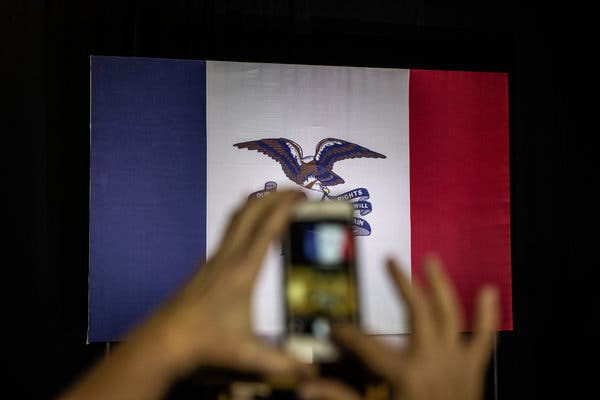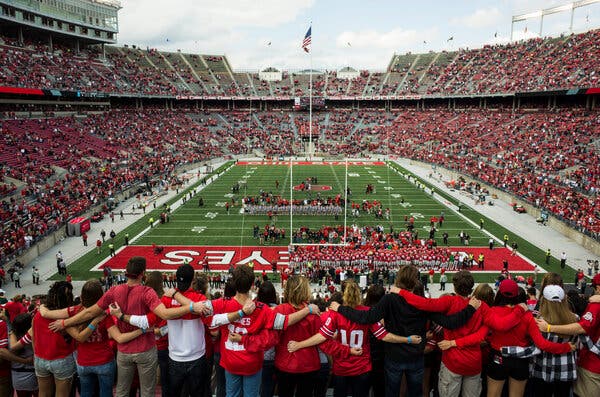DES MOINES — Every four years, Iowa is the top prize in politics, the first and perhaps most important jewel in the crown.
Ahead of every presidential election, candidates sprint across the first-in-the-nation nominating state to pitch themselves to voters as the best person to lead their party. But the 2020 Democratic primary, with its historically crowded field, has turned the quadrennial footrace into a hectic stampede.

There are the candidates, of course, who descend on the state in their painted buses and black SUVs, racing from middle school gymnasiums to coffee shops to senior centers to make their case to any heartland voter looking for a viable candidate.
But with them comes a storm of others: their campaign staffers, strategists, the political press, even voters from neighboring states eager to catch a glimpse of the next potential White House occupant.
Every four years, Iowa plays host to them all.
Iowa becomes a destination, no the destination, in politics, leading to the first caucuses that will begin the process of selecting the next president. This year they will be held on Feb. 3, less than a month from now.
Some Iowans love it. Suddenly, Iowa is not just a flyover state but a political mecca with the vaunted reputation of being able to predict a party’s eventual nominee (though it often doesn’t — ask Rick Santorum). Some Iowans come dressed for the part, dusting off their caucus uniforms like retired superheroes donning their capes: American flag suits, Abraham Lincoln top hats, Uncle Sam Halloween costumes.
Reporters fly into Des Moines and Cedar Rapids, then rent cars that they fill with remnants of Jimmy John’s sandwiches and pizza from Casey’s General Store. Driving back and forth on I-80, they can put 500 miles or more on these cars in a two-day span.
Members of the Waterloo Automotive Club at a parade in Independence.
A man caught a glimpse of a candidate surveying flood damage in Davenport.
Chris McBurney caught a glimpse of a candidate touring her neighborhood in Cedar Rapids.
Money flows in. Hotels are booked. Restaurants are full. Towns with less than 1,000 people — less than 500 people — are, briefly, the center of attention.
Brew pubs and high schools become must-stops on the campaign trail. Local parades and picnics draw national coverage. The annual state fair, with its butter cow and fried things on sticks, becomes a political summit. Potluck dinners hold the same weight as closed-door meetings on Capitol Hill. There are rallies and marches. There are drum lines and rock bands.
There comes a point when the race takes over. The candidates’ names are everywhere: On signs planted in yards. Blaring from billboards by the highway. Peering out of coffee shop windows.
Phones ring nonstop, with polls, with pleas. Who is your top choice? Am I your top choice? So many calls that Iowans stop picking up.
People start to hear. Cheers fill the room. The candidates, too, are all trying to hear, to speak. Mostly, though, they strut — on makeshift stages, set up to be torn down; through downtowns; right up to Iowans’ doors.
There are also moments of stillness: A local union hall before anyone arrives. A campaign office at dawn. A gym after a rally, when everyone has left.
Children and adults crowded a playground in Iowa City to watch a campaign event.
Richard Floss listened to a candidate speak at a tea house in Newton.
A campaign volunteer listened during an event at a middle school in Cedar Rapids.
But every four years, the rest of the nation watches as cornfields decay into barren horizon lines. The days become shorter, the weather colder, while at the same time the presence of each campaign only seems to become more and more permanent for each local resident.
It can be exhausting. The campaigning is, in the end, a performance, and Iowans see it as such. With as many as two dozen candidates at one point in the primary, it made for a lot of performances.
Iowa matters, but it is also being used. Vans filled with reporters clog the streets. Campaign events take over the sandwich shop, the college auditorium, the convention hall. Personal stories become source material for candidates’ plans and ideas.
Many Iowans don’t want to seem invested, but they are all giving up their Saturday nights. Some bring their kids to events, and ignore their pleas to go home. They bring their mothers and fathers. They bring their friends. They wait in line for selfies.
Campaigns begin to mark the time in weeks instead of months, days instead of weeks. One hundred and two days left. Forty-two. Weekdays in Iowa are, mostly, a respite: Many of the candidates have jobs back in Washington and return to the state on the weekends — Friday, Saturday, Sunday.
Some campaigns, beleaguered by money problems or low polling numbers, end before the caucuses. Their staffers move back home because home isn’t Iowa.
As the caucuses approach, the pressure of choosing a preferred candidate rises. Everyone is under scrutiny: The candidates but also the farmers, the teachers, the out-of-work factory workers.
Then an unsettling feeling creeps in. What happens when everyone leaves? When the store owners wave goodbye to the White House hopefuls because they have provided all their hope?
A camera crew found a creative exit from an event in Burlington.
After the Liberty and Justice dinner in Des Moines.
Chairs were stacked and flags removed after an event in Dubuque.
Thirty-nine days, thirty-one.
Every four years, Iowa is the belle of the ball. Everyone cares about Iowa.
Then it ends.
By sunrise after caucus night, everyone is gone. The hotel rooms are empty but the airport is full, everyone flying out, away.
But they will be back, they always come back.
